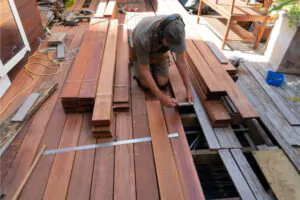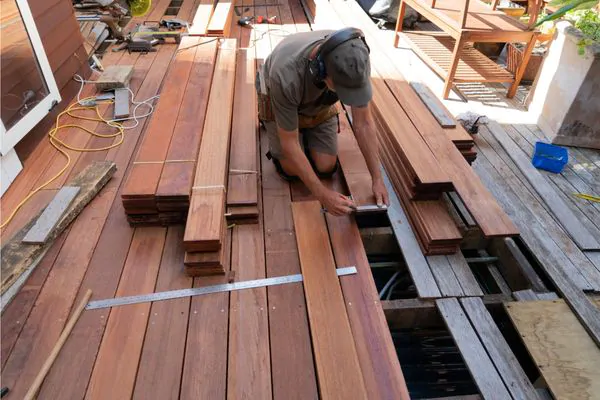Is your pool deck looking worn and outdated? You’re not alone. Many homeowners face the challenge of reviving their pool area. Learning how to refinish pool deck surfaces can transform your outdoor space from drab to fab.
SUNDEK, with over 50 years of experience, offers top-notch pool deck resurfacing solutions. This guide will walk you through the process of refinishing your pool deck. We’ll cover everything from assessing your current deck to choosing the right resurfacing option.
Get ready to create a stunning pool area that will be the envy of your neighborhood.
Key Takeaways
- Assess your pool deck’s condition for cracks, wear, and weathering before resurfacing to determine the best approach.
- Choose from stamped concrete overlays ($8-$15 per square foot), acrylic coatings, or epoxy-based systems (lasting 10-15 years) for resurfacing options.
- Properly prepare the surface by cleaning, repairing damage, and etching before applying the new coating for better adhesion and longevity.
- Seal the refinished deck and add non-slip additives for safety, allowing 24-48 hours for full curing.
- Maintain your resurfaced pool deck with regular cleaning and resealing every 2-3 years to preserve its appearance and extend its lifespan.
Assessing Your Current Pool Deck Condition
Checking your pool deck’s current state is crucial before starting any refinishing project. Look for cracks, chips, and signs of wear to decide if resurfacing is the right choice for your deck.
Check for cracks, wear, and weathering
Cracks, wear, and weathering can wreak havoc on your pool deck. These issues pose safety risks and may lead to costly repairs if left unchecked. SUNDEK experts can spot and fix cracks before resurfacing, ensuring a smooth and safe surface.
Poor repairs often result in trip and slip hazards, making professional assessment crucial.
A thorough inspection is the foundation of a successful pool deck resurfacing project.
Weathering and wear indicate the extent of damage to your deck. Sun exposure, harsh chemicals, and heavy foot traffic can degrade the surface over time. Addressing these issues early prevents further deterioration and extends the life of your pool deck.
A professional evaluation helps determine the best resurfacing method for your specific needs.
Determine suitability for resurfacing
Checking your pool deck’s condition helps decide if resurfacing is right for you. Look for signs of wear like cracks, chips, or fading. These issues might mean your deck needs more than a simple resurface.
Cementitious knockdown toppings offer a great option for many decks. They provide cool textures and can help lower surface temperatures. This makes them perfect for hot Colorado summers.
Bare concrete pool decks often need lots of upkeep. If you’re tired of constant maintenance, resurfacing could be the answer. DIY products exist for budget-conscious homeowners. These typically last one to two years before needing reapplication.
For longer-lasting results, professional resurfacing might be worth the investment. It can give your deck a fresh look and cut down on future repairs.
Options for Pool Deck Resurfacing
Pool deck resurfacing offers various options to revamp your outdoor space. You can choose from stamped concrete overlays, acrylic coatings, or epoxy-based systems to transform your pool area.
Stamped Concrete Overlays
Stamped concrete overlays offer a fresh look for tired pool decks. These thin layers mimic natural stone or wood, costing $8-$15 per square foot. Contractors spray or trowel the material onto existing surfaces, hiding damage and boosting curb appeal.
Modern products have improved slip resistance and bonding, making them ideal for Colorado’s varied climate.
Homeowners can choose from many patterns and colors to match their style. The overlays are tough, standing up to pool chemicals and foot traffic. They also provide a non-slip surface, crucial for safety around water.
With proper care, these overlays can last for years, making them a smart investment for pool owners.
Acrylic Coatings
Acrylic coatings provide a versatile solution for pool deck resurfacing in Colorado. SUNDEK’s customizable options come in various colors and textures, allowing homeowners to improve their deck’s appearance and functionality.
These coatings increase property value and attract visitors with their appealing finish.
Durability is a key feature of acrylic coatings. With proper care, SUNDEK surfaces can last 10 to 25 years. This long-lasting quality makes acrylic coatings an excellent choice for Colorado residents wanting to upgrade their pool areas without frequent replacements.
Epoxy-Based Systems
Epoxy-based systems offer a tough and attractive option for pool deck resurfacing. These coatings last 10 to 15 years, making them a durable choice for Colorado homeowners. Epoxy paints create a smooth surface that fills small cracks, improving the deck’s look and feel.
For a standard 12×24 pool, you’ll need about 8 gallons of epoxy. The cost ranges from $3 to $5 per square foot, with materials and labor totaling around $1,500 for an average-sized deck.
Epoxy coatings provide several benefits for pool decks. They resist wear and tear from foot traffic and harsh weather. The smooth finish is easy to clean and maintain, saving time on upkeep.
Many color options allow you to match your home’s style or create a unique look. Epoxy also offers slip-resistant properties, which is crucial for safety around wet areas. This resurfacing method gives old concrete a fresh, modern appearance without the need for costly replacements.
Step-by-Step Guide to Refinishing Your Pool Deck
Refinishing your pool deck can transform your outdoor space. Our step-by-step guide walks you through the process, from prep work to final touches.
Surface preparation and cleaning
Pool deck resurfacing starts with proper surface preparation and cleaning. This crucial step ensures the new coating adheres well and lasts longer. Here’s a detailed guide to prepare your pool deck:
- Remove all furniture and objects from the deck.
- Sweep the entire surface to remove loose debris and dirt.
- Pressure wash the deck to remove stubborn grime and stains.
- Inspect the deck for cracks, chips, or uneven areas.
- Repair any damaged areas with concrete filler or patching compound.
- Allow repairs to dry completely before proceeding.
- Use a concrete etcher or grinder to roughen the surface for better adhesion.
- Clean the deck again to remove dust from etching or grinding.
- Apply a degreaser to remove any oil or grease spots.
- Rinse the deck thoroughly with clean water.
- Allow the deck to dry completely before applying any new coating.
- Tape off areas you don’t want to coat, such as pool edges or landscaping.
- Cover nearby plants or structures to protect them from overspray.
Application of chosen resurfacing material
Pool deck resurfacing breathes new life into your outdoor space. Here’s a step-by-step guide to apply your chosen resurfacing material:
- Mix the resurfacing product according to instructions. Triple Crown cleaner and etcher should be prepared in three gallons for optimal results.
- Apply the first coat of COOL! product thickly using a roller or sprayer. This ensures good coverage and adhesion to the surface.
- Allow the first coat to dry completely. This usually takes 2-4 hours, depending on weather conditions.
- Apply a second coat for consistency and durability. This layer helps fill any missed spots and creates a uniform finish.
- Use protective tape on surrounding areas before application. This prevents overspray and keeps other surfaces clean.
- Smooth the surface with a trowel or broom for desired texture. This step helps create a non-slip surface for safety around the pool.
- Let the final coat cure for 24-48 hours before use. This allows the product to set properly and reach full strength.
- Apply a clear concrete sealer for added protection. This helps guard against UV damage and extends the life of your resurfaced deck.
Sealing and finishing touches
Sealing and finishing touches are crucial steps in pool deck refinishing. These final stages protect your investment and enhance the deck’s appearance. Here’s what you need to know:
- Clean the surface thoroughly before sealing
- Remove all dirt, dust, and debris
- Use a pressure washer for best results
- Choose the right sealer for your deck material
- Concrete sealers for concrete decks
- Acrylic sealers for acrylic coatings
- Apply the sealer evenly
- Use a roller or sprayer for large areas
- Work in small sections to ensure full coverage
- Allow proper drying time
- Follow manufacturer’s instructions
- Typically 24-48 hours for full cure
- Add non-slip additives for safety
- Mix with sealer before application
- Helps prevent slips and falls around the pool
- Apply a second coat if needed
- Enhances durability and protection
- Wait for first coat to dry completely
- Maintain the sealed surface
- Reseal every 2-3 years for best results
- Clean regularly to extend sealer life
- Add decorative touches
- Paint pool deck borders for a finished look
- Install LED lights for nighttime ambiance
Maintenance Tips Post-Resurfacing
Proper care after refinishing extends your pool deck’s life and beauty. Read on for essential upkeep tips.
Routine cleaning guidelines
Keep your pool deck clean with regular sweeping and rinsing. Use a soft-bristle brush or leaf blower to remove debris weekly. Hose down the deck surface to prevent dirt buildup. For tougher stains, apply a mild detergent and scrub gently with a brush.
Avoid harsh chemicals that could damage the deck coating. Rinse thoroughly after cleaning to maintain the deck’s appearance and prevent slipping hazards.
Brush your pool daily for the first week after resurfacing to ensure proper curing. Test water chemistry weekly and perform shock treatments as needed. This routine helps preserve the deck’s finish and extends its lifespan.
In spring, give your deck a thorough cleaning to prepare for heavy use during summer months. Regular maintenance keeps your pool deck looking great and safe for swimmers.
Periodic resealing recommendations
Pool decks need regular resealing to stay in top shape. Experts suggest resealing COOL! pool decks every 2-3 years. This timeline can change based on how much sun and foot traffic your deck gets.
Before you reseal, make sure to clean the surface well. Apply the new coat and let it dry for at least 24 hours. This care will keep your pool deck looking great and safe to use for years to come.
Conclusion
Refinishing your pool deck transforms your outdoor space. With the right approach, you can create a stunning, durable surface that enhances your property value. It’s important to assess your deck’s condition, choose the best resurfacing option, and follow proper maintenance.
Your newly refinished pool deck will provide years of enjoyment and beauty. Start the process and give your pool area the makeover it deserves.
FAQs
1. What are the best pool deck resurfacing options?
Popular choices for pool deck resurfacing include concrete coatings, exposed aggregate, cool deck, and decorative concrete. These options offer durability, slip-resistance, and aesthetic appeal. Concrete resurfacing is cost-effective and can give your old pool deck a new look without breaking the bank.
2. How much does it cost to resurface a pool deck?
The cost to resurface a pool deck varies based on the size, condition of the existing surface, and chosen materials. Concrete resurfacing is often less expensive than replacing the entire deck. DIY-friendly options like pool deck paint can save money, while professional services for decorative concrete or exposed aggregate may cost more.
3. Can I resurface my pool deck myself?
Yes, DIY pool deck resurfacing is possible with certain products. Pool deck coatings and paints are easy to apply and offer a quick refresh. However, for more complex resurfacing methods like knockdown texture or thin layer concrete overlays, professional help ensures better results and longevity.
4. What types of pool deck coatings are available?
Pool deck coatings come in a wide range of options. Acrylic paints provide color and protection. Concrete coatings offer durability and customization. Cool deck products reduce surface temperatures. Some coatings mimic natural stone or provide a non-slip texture for safety.
5. How long does pool deck resurfacing last?
The lifespan of a resurfaced pool deck depends on the product used and maintenance. Quality concrete resurfacing can last 5-10 years or more. Regular cleaning, sealing, and protection from UV rays and chemicals extend the life of your resurfaced deck. Proper care keeps your pool space looking great for years.
6. What preparation is needed before resurfacing a pool deck?
Proper preparation is crucial for successful resurfacing. Start by pressure washing the existing concrete to remove dirt and debris. Repair any cracks or damage. Sand rough spots and apply an acid etching solution if needed. Ensure the surface is clean, dry, and ready for the new coating or concrete overlay for best results.









